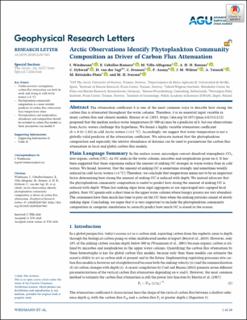Arctic Observations Identify Phytoplankton Community Composition as Driver of Carbon Flux Attenuation
Wiedmann, Ingrid; Ceballos-Romero, E.; Villa-Alfageme, M.; Renner, Angelika; Dybwad, Christine; van der Jagt, Helga; Svensen, Camilla; Assmy, Philipp; Wiktor, Josef; Tatarek, Agnieszka; Różańska‐Pluta, M.; Iversen, Morten H.
Peer reviewed, Journal article
Published version
Permanent lenke
https://hdl.handle.net/11250/2684800Utgivelsesdato
2020Metadata
Vis full innførselSamlinger
- Articles [3012]
- Publikasjoner fra CRIStin [3070]
Sammendrag
The attenuation coefficient b is one of the most common ways to describe how strong the carbon flux is attenuated throughout the water column. Therefore, b is an essential input variable in many carbon flux and climate models. Marsay et al. (2015, https://doi.org/10.1073/pnas.1415311112) proposed that the median surface water temperature (0–500 m) may be a predictor of b, but our observations from Arctic waters challenge this hypothesis. We found a highly variable attenuation coefficient (b = 0.43–1.84) in cold Arctic waters (<4.1 °C). Accordingly, we suggest that water temperature is not a globally valid predictor of the attenuation coefficient. We advocate instead that the phytoplankton composition and especially the relative abundance of diatoms can be used to parametrize the carbon flux attenuation in local and global carbon flux models.
